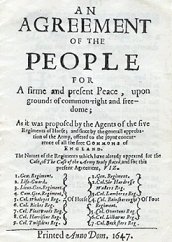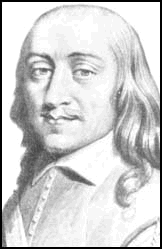
The Banbury mutiny was a mutiny by soldiers in the English New Model Army. The mutineers did not achieve all of their aims and some of the leaders were executed shortly afterwards on 17 May 1649.

The Banbury mutiny was a mutiny by soldiers in the English New Model Army. The mutineers did not achieve all of their aims and some of the leaders were executed shortly afterwards on 17 May 1649.
The mutiny was over pay and political demands. The pay issue was defused by Oliver Cromwell acknowledging the justice of the soldiers' financial grievances and securing £10,000 towards payment of arrears from Parliament. But 400 troopers under the command of Captain William Thompson who were sympathetic to the Levellers set off from Banbury, where they were billeted, to speak with other regiments at Salisbury about their political demands.
Major White was sent by Cromwell and Thomas Fairfax to mediate with Thompson's troops and give assurances that force would not be used against them. However, on 13 May Cromwell launched a night attack. Several mutineers were killed in the skirmish. Captain Thompson escaped only to be killed a few days later in another skirmish near the Diggers community at Wellingborough. After being imprisoned in Burford Church with the other mutineers, [1] three other leaders were shot: Private John Church, Corporal Perkins, and Cornet James Thompson (William Thompson's brother), on 17 May 1649. [2] This destroyed the Levellers' power base in the New Model Army.
Each year since 1975, Levellers' Day has been held in the Oxfordshire town of Burford to commemorate the three Levellers executed there. [3] A different theme is chosen for each Levellers' Day, which is held on the Saturday nearest to 17 May, and speakers are invited to speak on the theme during the morning; this is followed by a procession around the town and a ceremony in the churchyard. In the afternoon there is music and other entertainment usually held in the garden of Warwick Hall which is next to the church. In 1979 a plaque to the three soldiers on the church wall was unveiled by Tony Benn to commemorate the event. [4]

Oliver Cromwell was an English statesman, politician, and soldier, widely regarded as one of the most important figures in the history of the British Isles. He came to prominence during the 1639 to 1653 Wars of the Three Kingdoms, initially as a senior commander in the Parliamentarian army and latterly as a politician. A leading advocate of the execution of Charles I in January 1649, which led to the establishment of The Protectorate, he ruled as Lord Protector from December 1653 until his death in September 1658. Cromwell remains a controversial figure due to his use of the army to acquire political power, and the brutality of his 1649 campaign in Ireland.

The Levellers were a political movement active during the Wars of the Three Kingdoms who were committed to popular sovereignty, extended suffrage, equality before the law and religious tolerance. The hallmark of Leveller thought was its populism, as shown by its emphasis on equal natural rights, and their practice of reaching the public through pamphlets, petitions and vocal appeals to the crowd.

The New Model Army or New Modelled Army was a standing army formed in 1645 by the Parliamentarians during the First English Civil War, then disbanded after the Stuart Restoration in 1660. It differed from other armies employed in the 1639 to 1653 Wars of the Three Kingdoms in that members were liable for service anywhere in the country, rather than being limited to a single area or garrison. To establish a professional officer corps, the army's leaders were prohibited from having seats in either the House of Lords or House of Commons. This was to encourage their separation from the political or religious factions among the Parliamentarians.
Edward Whalley was an English military leader during the English Civil War and was one of the regicides who signed the death warrant of King Charles I of England.

Burford is a town on the River Windrush, in the Cotswold hills, in the West Oxfordshire district of Oxfordshire, England. It is often referred to as the 'gateway' to the Cotswolds. Burford is located 18 miles (29 km) west of Oxford and 22 miles (35 km) southeast of Cheltenham, about 2 miles (3 km) from the Gloucestershire boundary. The toponym derives from the Old English words burh meaning fortified town or hilltown and ford, the crossing of a river. The 2011 Census recorded the population of Burford parish as 1,422.

The Second English Civil War took place between February and August 1648 in England and Wales. It forms part of the series of conflicts known collectively as the 1639–1653 Wars of the Three Kingdoms, which include the 1641–1653 Irish Confederate Wars, the 1639–1640 Bishops' Wars, and the 1649–1653 Cromwellian conquest of Ireland.
Levellers were an English 17th century political movement active during English Civil War. It may also refer to

The Putney Debates, which took place from 28 October to 8 November 1647, were a series of discussions over the political settlement that should follow Parliament's victory over Charles I in the First English Civil War. The main participants were senior officers of the New Model Army who favoured retaining Charles within the framework of a constitutional monarchy, and radicals such as the Levellers who sought more sweeping changes, including one man, one vote and freedom of conscience, particularly in religion.
The Corkbush Field Mutiny occurred on 15 November 1647, during the early stages of the Second English Civil War at the Corkbush Field rendezvous, when soldiers were ordered to sign a declaration of loyalty to Thomas Fairfax, the commander-in-chief of the New Model Army (NMA), and the Army Council. When some refused to do this they were arrested, and one of the ringleaders, Private Richard Arnold, was executed.
The Bishopsgate mutiny occurred in April 1649 when soldiers of Colonel Edward Whalley's regiment of the New Model Army refused to obey orders and leave London. At the end of the mutiny one soldier, a supporter of the Levellers, Robert Lockyer, was executed by firing squad.

Robert Lilburne (1613–1665) was an English Parliamentarian soldier, the older brother of John Lilburne, the well known Leveller. Unlike his brother, who severed his relationship with Oliver Cromwell, Robert Lilburne remained in the army. He is also classed as a regicide for having been a signatory to the death warrant of King Charles I in 1649. He was forty-seventh of the fifty nine Commissioners.
Colonel Sir Richard Ingoldsby was an English officer in the New Model Army during the English Civil War and a politician who sat in the House of Commons variously between 1647 and 1685. As a Commissioner (Judge) at the trial of King Charles I, he signed the king's death warrant but was one of the few regicides to be pardoned.
The Interregnum was the period between the execution of Charles I on 30 January 1649 and the arrival of his son Charles II in London on 29 May 1660, which marked the start of the Restoration. During the Interregnum, England was under various forms of republican government.
The Army Council was a body established in 1647 to represent the views of all levels of the New Model Army. It originally consisted of senior commanders, like Sir Thomas Fairfax, and representatives elected by their regiments, known as Agitators.

Thomas Rainsborough, or Rainborowe, 6 July 1610 to 29 October 1648, was an English religious and political radical who served in the Parliamentarian navy and New Model Army during the Wars of the Three Kingdoms. One of the few contemporaries whose personal charisma and popularity rivalled that of Oliver Cromwell, he has also been described as "a soldier of impressive professional competence and peerless courage".
Thomas Rawton was one of the highest-ranking officers to support the Levellers, and served with Parliament on both land and sea. He was the eldest son of Captain John Rawton, a naval officer who made his fortune in the Baltic trade, and inherited his father's property in the London Borough of Southwark.
Events from the year 1649 in England. The Second English Civil War ends and the Third English Civil War begins.
Robert Lockyer was an English soldier in Oliver Cromwell's New Model Army. A Leveller, he was the only soldier executed for his involvement in the Bishopsgate mutiny.
John Reynolds (1625–1657) was a soldier in the English Civil War and during the Commonwealth. Reynolds may have been a member of the Middle Temple. He joined the parliamentary army, and in 1648 he commanded a regiment of horse. He took part in the Cromwellian conquest of Ireland. He was a member of the Westminster-based Protectorate Parliament for Galway and Mayo in 1654 and Waterford and Tipperary in 1656. He was knighted in 1655. In 1657 he commanded the English force which cooperated with the French in Flanders in the Anglo-Spanish War and was lost at sea when returning to England.
William Eyre was an English Parliamentary army officer in the English Civil War and a Leveller.